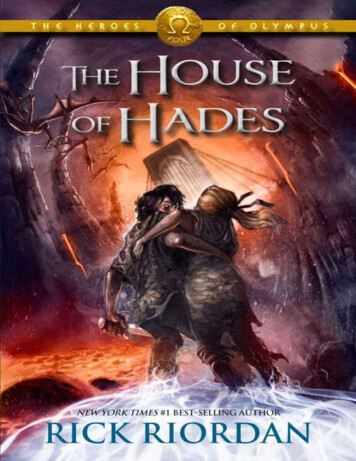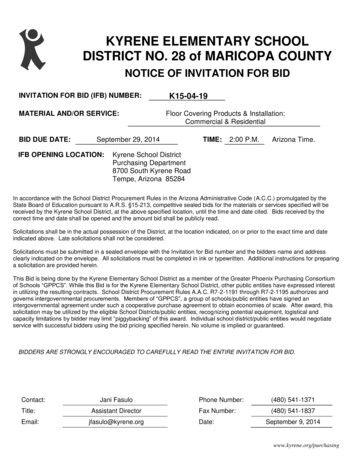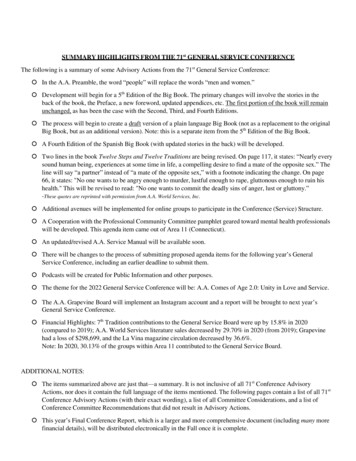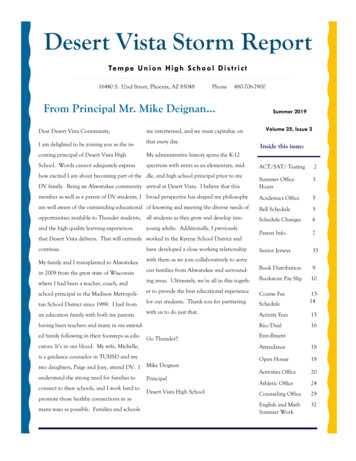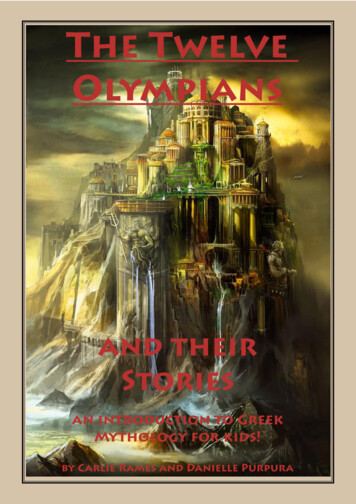
Transcription
The TwelveOlympiansand theirStoriesan introduction to GreekMythology for kids!by Carlie Rames and Danielle Purpura
Table ofContentsIntroductionThe Twelve loArtemisDionysusAthenaHermesAphroditeGreeceFamily TreeGlossary456810121416182022242628 303132
IntroductionWho are the Twelve Olympians you ask? What are their stories and what werethe roles they played in classical Greek culture? Well you’ll find the answers to all thosequestions here and more in this brief exploration into Greek mythology.To specify, Greek mythology is the body of myths and teachings that belong tothe ancient Greeks, concerning their gods and heroes, and the nature and origin of theworld. When we say ancient Greece, we mean ancient! This period lasted from around800 BCE until about 600 AD. Their mythology was a part of the religion in ancientGreece. Modern scholars refer to and study the myths in an attempt to understand thereligious and political elements of Ancient Greece and its civilization. Greek mythologyis told through a large collection of written texts, and in Greek representational arts,such as vase-paintings and sculpture. Greek myth attempts to explain the origins ofthe world, and details the lives and adventures of a wide variety of gods, goddesses,heroes, heroines, and mythological creatures. These accounts initially were spread in anoral-poetic tradition (passed on from generation to generation by parents telling theirchildren these stories and poems); but today the Greek myths are known primarilyfrom Greek literature.The amount of myths and stories that the Greeks created is incredibly large. Eachgod has stories that not only relate to other gods, but to mortals (or regular humanslike you and me) as well. The Greeks were very creative in the way that they chose toexplain the world around them. Imagine not knowing why the seasons changed or whythere were stars in the sky! The Greeks had to think up sometimes fantastical ideas inorder to understand the world and its happenings.The twelve gods and goddesses we will discuss here are called the TwelveOlympians. They are called Twelve Olympians because, you guessed it, there weretwelve of them, and they all lived in the sky on top of a huge mountain called MountOlympus. The Greeks believed that this mountain was so tall that it touched the sky.These twelve gods were the principal characters in many of the Greek myths and theyall played important roles in everyday classical Greek life.In this book, you’ll meet all the major gods in Greek mythology and you’ll evensee how these stories affect us today!
The usApolloArtemesDionysusAthenaHermesAphrodite
ZeusKing of GodsHis symbols are thethunderbolt, eagle,bull, and oakIn addition, Zeus is frequently depictedby Greek artists in one of two poses:standing, striding forward, with athunderbolt raised in his right hand, orseated in majesty.
Zeus is the «Father ofGods and men» who rulesthe Olympians of MountOlympus as a father rulesa family according toancient Greek religion.the job of distracting Herafrom his affairs by talkingincessantly, and when Heradiscovered the deception,she cursed Echo to repeatthe words of others.He is the god of sky andthunder. Zeus is the childof Cronus and Rhea, andis the youngest of hissiblings. He is marriedto Hera, although, he isknown to have fatheredmany children with otherwomen.TheCyclopesgave him thethunderboltas a gift.These resulted in manygodly and heroic offspring,includingAthena,Apollo and Artemis,PersephoneHermes,(by Demeter), Dionysus,and Heracles; by Hera,he is usually said tohave fathered Ares andHephaestus. For a time, anymph named Echo had
HeraQueen of godsGoddess of marriageand familyHer symbols arethe peacock,pomegranate,cuckoo, lion andcrownHera is portrayed as majestic andsolemn, often enthroned, and crowned,she usually is seen with a pomegranatein her hand, emblem of both fertilityand death. Hera was known for herjealous and vengeful nature, mostnotably against Zeus’s lovers andoffspring, but also against mortals whocrossed her.
Hera is the wife of Zeus.Her chief function is asthe goddess of womenand marriage.She presides over theright arrangements ofthe marriage and is thearchetype of the unionin the marriage bed, butshe is not notable as amother.The only child that shehad with Zeus was Ares.Hera was jealous of Zeus’giving birth to Athena, so,according to the myth, shegave birth to Hephaestuswithout him. Hera wasthen disgusted withHephaestus’ ugliness andthrew him from MountOlympus to the earthbelow.by making her a magicalthrone which, when shesat on, did not allow her toleave. The other gods beggedHephaestus to return toMount Olympus to lether go, but he repeatedlyrefused. The god of wine,Dionysus persuaded himand took him back to MountOlympus. Hephaestus thenfinally released Hera afterbeing given Aphrodite as hiswife. Hera was most knownas the matron goddess, HeraTeleia; but she presided overweddings as well.However,Hephaestusgained revenge againstHera for rejecting him
PoseidonGod of the SeaHis symbols aredolphins and threepronged fish spears(tridents)Poseidon rides a chariot that was pulledby horses that could ride on the sea.He lived in a palace on the ocean floor,made of coral and gems. He is usuallydepicted as an older male with curly hairand beard.1010
Poseidon was seen as thecreator of new islands andcalm seas. When offendedor ignored, he supposedlystruckthegroundwith his trident andcaused chaotic springs,earthquakes, drowningsand shipwrecks. Sailorsoften prayed to Poseidonfor a safe voyage.The City of AthensAthena (see page 22)becamethepatrongoddess of the city ofAthens after a competitionwith Poseidon. At a festivalat the end of the year inthe Athenian calendar, thepriests of Athena and thepriest of Poseidon agreedthat each would give theAthenians one gift andthe Athenians wouldchoose whichever giftthey preferred. Poseidonstruck the ground with histrident and a spring sprangup; the water was salty andnot very useful, whereasAthena offered them anolive tree. The Atheniansaccepted the olive tree andalong with it Athena as theirpatron, for the olive treebrought wood, oil and food.After the fight, infuriatedat his loss, Poseidon sent amonstrous flood, to punishthe Athenians for notchoosing him. The contestof Athena and Poseidonwas is now drawn above theentrance to the Parthenon,the first sight that all visitorssee when they visitthe Parthenon.11
DemeterGoddess of theharvestHer symbols are thepoppy, wheat, torchand pigShe presided over grains and the fertilityof the earth. Though Demeter is oftendescribed simply as the goddess of theharvest, she presided also over thesanctity of marriage, and the cycle oflife and death. Demeter’s emblem is thepoppy, a bright red flower that growsamong the barley. Demeter was usuallyportrayed on a chariot, and frequentlyassociated with images of the harvest,including flowers, fruit, and grain. Shewas also sometimes pictured with herdaughter Persephone.1212
The seasonsDemeter’s virgin daughterPersephone was abductedto the underworld by Hadesafter Hades fell in love withher upon seeing her beauty.Demeter searched for herwithout stopping, preoccupiedwith her loss and her grief. Theseasons halted; living thingsceased their growth, thenbegan to die. Faced with theextinction of all life on earth,Zeus sent his messengerHermes to the underworldto bring Persephone back.Hades agreed to release her,but tricked her into eatingan enchanted pomegranate.When she ate the pomegranateseeds, she was bound to him forone fourth of the year. Thus,Demeter was allowed to be withher daughter for three fourthsof the year (spring, summer,and fall) during which plantsblossom and bloom and cropsproduce food because Demeteris happy. However, during thefouth part of the year whenPersephone is away from herin the underworld (winter),nothinggrowsbecauseDemeter is so stricken with griefand missing her daughter.How man learned to harvestcropsDemeter’s search for her daughterlead her to an enormous king’scastle. She assumed the formof an old woman, and askedthe king for shelter. He tookher in to help him care for hissons. To reward his kindness,she planned to make one of thesons immortal; she secretlyanointed the boy with ambrosiaand laid him in the flames of thehearth, to gradually burn awayhis mortal self. But suddenly,his mother walked in, saw herson in the fire and screamed infright. Demeter abandoned theattempt. Instead, she taught theother son the secrets ofagriculture, and he inturn taught them to anywho wished to learn them.Thus, humanity learned howto plant, grow and harvestgrain.13
AresGod of warHis symbols arethe spear, thehelmet, the dog, thechariot and thebearIn Greek literature, he often representsthe physical or violent and untamedaspect of war, in contrast to the armoredAthena, whose functions as a goddessof intelligence include military strategyand generalship.1414
The Greeks were ambivalenttoward Ares: although heembodied the physical valornecessary for success in war,he was a dangerous force,«overwhelming, insatiable inbattle, destructive, and manslaughtering.” Fear (Phobos)and Terror (Deimos) werethe horses that pulled hisbattle chariot.Ares is the son of Zeusand Hera, but he plays arelatively limited role inGreek mythology, thoughhis numerous love affairsand abundant offspring areoften alluded to. When Aresdoes appear in myths, hetypically faces humiliation.He is well known as the loverof Aphrodite, the goddessof love (see page 26), whowas married to Hephaestus,god of craftsmanship (seepage 14). The most famousstory related to Ares andAphrodite shows themexposed to ridicule throughthe wronged husband’sclever device. In the tale, theSun-god Helios once spied Aresand Aphrodite kissing eachother secretly. He reportedthe incident to Hephaestus.Contriving to catch them,Hephaestus fashioned a finelyknitted and nearly invisiblenet with which to snare them.At the appropriate time, thisnet was sprung, and trappedAres and Aphrodite locked invery private embrace.But Hephaestus was notsatisfied with his revenge,so he invited the Olympiangods and goddesses toview the unfortunate pairin their shame. Once thecouple were loosed,Ares, embarrassed,returnedtohishomeland, Thrace, andAphrodite went to Paphoswhere she was born.15
HephaestusGod of blacksmiths,craftsmen, artisans,sculptors, metals, fireand volcanoesHis symbols are asmith’s hammer,anvil, and a pair oftongsHe is often depicted hunching or sittingdown because of his injuries1616
As a smithing god,Hephaestus made all theweapons of the gods inOlympus. He served asthe blacksmith of thegods, and was worshippedinthemanufacturingand industrial centres ofGreece, particularly Athens.He designed Hermes’ (seepage 24) winged helmetand sandals, Aphrodite’sfamed girdle, Achilles’armor, Helios’ chariot,and Eros’ bow and arrows.Prometheus stole thefire that he gave to manfrom Hephaestus’ forge.Hephaestus also created thegift that the gods gave toman, the woman Pandoraand her famous box.Being a skilled blacksmith,Hephaestus created all thethrones in the Palace ofOlympus.According to differentsources, he is either the sonof Zeus and Hera together,or Hera gave birth to himby herself. In both myths,Hera was then disgustedwith Hephaestus’ uglinessand threw him from MountOlympus to the earth below.However, Hephaestus gainedrevenge against Hera forrejecting him by making hera magical throne which, whenshe sat on, did not allow her toleave. The other gods beggedHephaestus to return to MountOlympus to let her go, but herepeatedly refused. The godof wine, Dionysus persuadedhim and took him back toMount Olympus. Hephaestusthen finally released Heraafter being given Aphrodite ashis wife.H e p h a e s t u sisreportedinmythological source aslame. He was depictedwith crippled feet and asmisshapen, as a resultof his fall fromOlympus.17
ApolloGod of light andthe sunHis symbols are thelyre, the laurelwreath, the raven,and the bow andarrow.The ideal of the kouros (a beardless,athletic youth), Apollo is the son of Zeusand Leto, and has a twin sister, thechaste huntress Artemis.1818
As the patron of Delphi, Apollo wasan oracular god - the prophetic deityof the Delphic Oracle. Medicine andhealing are associated with Apollo,yet Apollo was also seen as a godwho could bring ill-health and deadlyplague. Amongst the god’s custodialcharges, Apollo became associatedwith dominion over colonists, andas the patron defender of herds andflocks. As the leader of the Musesand director of their choir, Apollofunctioned as the patron god ofmusic and poetry. Hermes createdthe lyre for him, and the instrumentbecame a common attribute ofApollo. Hymns sung to Apollo werecalled paeans.When Zeus’ wife Hera discoveredthat Leto was pregnant, she bannedLeto from giving birth on land. Letofound the newly created floatingisland of Delos, which was neithermainland nor a real island. Shegave birth there and was acceptedby the people, offering them herpromise that her son would bealways favourable toward the city.Afterwards, Zeus secured Delos tothe bottom of the ocean. This islandlater became sacred to Apollo. Itis also stated that Hera kidnappedEileithyia, the goddess of childbirth,to prevent Leto from going intolabor. The other gods tricked Herainto letting her go by offering her anecklace, nine yards (8 m) long, ofamber. Most believed that Artemiswas born first and then assisted withthe birth of Apollo.Four days after his birth, Apollo killedthe dragon Python, which lived inDelphi. Hera sent the serpent to huntLeto to her death across the world.To protect his mother, Apollo beggedHephaestus for a bow and arrows. Afterreceiving them, Apollo cornered Pythonin the sacred cave at Delphi.Apollo’s LyreOne night while Hermes was still ababy, his mother, Maia, had wrappedhim in blankets but Hermes escapedwhile she was asleep. Hermes ran away,and stumbled upon where Apollo wasgrazing his cattle. The baby Hermes stolea number of his cows and took them toa cave. In the cave, he found a tortoiseand killed it. He used one of the cow’sinsides and the tortoise shell and madethe first lyre.Apollo complained to Maia that her sonhad stolen his cattle, but Hermes hadalready replaced himself in the blanketsshe had wrapped him in,so Maia refused to believeApollo’s claim. Zeus intervenedand, claiming to have seen theevents, sided with Apollo. Hermesthen began to play music on the lyrehe had invented. Apollo, a godof music, fell in love with theinstrument and offeredto allow exchangeof the cattle forthelyre.19
ArtemisGoddess of the hunt, wildanimals, wilderness, childbirth,virginityHer symbols are thestag, the cypresstree and the moonShe is protector of young girls, bringingand relieving disease in women. Sheoften is depicted as a huntress carryinga bow and arrows.2020
Artemis is the daughter of Zeusand Leto, and has a twin brother,Apollo. When Zeus’ wife Heradiscovered that Leto was pregnantand that Zeus was the father, shebanned Leto from giving birthon land. In her wanderings, Letofound the newly created floatingisland of Delos, which was neithermainland nor a real island. Shegave birth there and was acceptedby the people, offering them herpromise that her son would bealways favourable toward the city.Afterwards, Zeus secured Delosto the bottom of the ocean.It isalso stated that Hera kidnappedEileithyia, the goddess ofchildbirth, to prevent Leto fromgoing into labor. The other godstricked Hera into letting her goby offering her a necklace, nineyards (8 m) long, of amber. Mostbelieved that Artemis was bornfirst and then assisted with thebirth of Apollo.ActaeonActaeon was a hunting companionof the goddess. One day, he triedto spy on her bathing naked inher sacred spring. Upon seeingher natural beauty, he attemptsto force himself on her. For this,Athena in her rage turns him intoa stag and he is devoured by hisown hunting dogs who no longerrecognize their master.The Aloadae: These twin sons, Otosand Ephialtes, grew enormously ata young age. They were aggressive,great hunters, and could not be killedunless they killed each other. Thegrowth of the twins never stopped,and they boasted that as soon asthey could reach heaven, they wouldkidnap Artemis and Hera and takethem as wives. The gods were afraidof them, except for Artemis whochanged herself into a doe and jumpedout between them. The twins boththrew their spears at the doe and somistakenly killed each other.CallistoCallisto was a princess and also wasone of Artemis’s hunting attendants.As a companion of Artemis, she tooka vow of chastity. Zeus appeared toher disguised as Artemis, gained herconfidence, then took advantageof her. As a result of this encountershe conceived a son, Arcas. Enraged,Artemis and Hera changedher into a bear. Her sonalmost killed the bear, butZeus stopped him just intime. Out of pity, Zeus placedboth Arcas and Callisto into theheavens as bears, forming theLittle Dipper (Ursa Minor)and the Big Dipper(UrsaMajor)constellations.21
DionysusGod of the grape harvest,winemaking and wine, ofritual and ecstasyHis symbols are thebull, serpent, ivy,and wineIn Greek mythology, he is presented asa son of Zeus and the mortal Semele,thus semi-divine. Dionysus was the lastgod to be accepted into Mt. Olympus.He was the youngest and the only one tohave a mortal mother.2222
Semele was a priestess of Zeus, and heonce watched her slaughter a bull at hisaltar and afterwards swam in a river tocleanse herself of the blood. Zeus fell inlove with Semele and repeatedly visitedher secretly.Zeus’ wife, Hera, discovered his affairwhen Semele later became pregnant.Appearing as an old, ugly woman,Hera befriended Semele, who told herthat her lover was actually Zeus. Heraplanted seeds of doubt in Semele’smind. Curious, Semele asked Zeus togrant her a favor. Zeus promised onthe River Styx to grant her anythingshe wanted. She demanded that Zeusreveal himself in all his glory as proofof his godhood. Though Zeus beggedher not to, she persisted and he wasforced by his oath to comply. Mortals,however, cannot look upon Zeus in histrue God form, and she perished uponseeing him. Zeus rescued Dionysus,and gave the infant to Hermes.One version of the story is that Hermestook the boy to King Athamas and hiswife Ino, Dionysus’ aunt. Hermes badethe couple raise the boy as a girl, to hidehim from Hera’s wrath.His festivals were the driving forcebehind the development of Greektheatre. When Dionysus grew up, hediscovered the culture of the vine andthe mode of extracting its precious juice;but Hera struck him with madness, anddrove him to wander through variousparts of the earth. Rhea was able tocure him and he set out on a journeythrough Asia teaching the people thecultivation of the vine. The most famouspart of his wanderings is his expeditionto India. Returning in triumph hedecided to teach all that he had learnedto the Greeks, but was opposed by somewho dreaded its introduction on accountof the disorders and madness that alcohollead to.King Midas:Once, Dionysus’ old school master andfoster father went missing and was foundby some peasants who carried him totheir king. King Midas recognized him,and treated him hospitably, hosting himfor ten days and nights. On the eleventhday, he brought Silenus back to Dionysus.Dionysus offered Midas whatever rewardhe wanted.Midas asked that whatever he might touchshould be changed into gold. Dionysusconsented, though was sorry that he hadnot made a better choice. Midas excitedlytouched and turned to gold an oak twigand a stone. As soon as he got home,though, he found that his bread, meat,and wine all turned to gold as soon as hetouched it. Worst of all, when he brushedhis daughter’s hand with his own, she wasturned to gold as well. Upset, Midas stroveto rid himself of his power(theMidas Touch); he hated thegift he had coveted. He prayedto Dionysus who heard andconsented; he told Midas to washin the river Pactolus. He did so, andwhen he touched the waters the powerpassed into them, and the riversands changed into gold. Thismyth explained why the sandsof the Pactolus wererich in gold.23
AthenaGoddess of wisdom,courage, civilization,law and justice,strategy and the artsHer symbols arethe owl, the olivetree, the snake, thehelmet and thespearShe is a companion of heroes and isthe goddess of heroic endeavour. She isthe virgin patron saint of Athens. TheAthenians founded the Parthenon onthe Acropolis of her namesake city,Athens (Athena Parthenos), in herhonor.2424
Athena was the favorite daughterof Zeus, born fully armed from hisforehead. Zeus lay with Metis, thegoddess of crafty thought and wisdom,but he feared the consequences. Itwas prophesied that Metis would bearchildren more powerful than the father,even Zeus. In order to stop these direconsequences, after lying with Metis,Zeus ‘put her away inside his ownbelly’. However, he was too late: Metishad already conceived. Eventually Zeusexperienced an enormous headache,seeking Hephaestus for help. He struckZeus’s head with a double-headed axe.Athena then leaped from Zeus’s head,fully grown, armed and armoured witha shout.Athena never had a consort or lover andis thus known as Athena Parthenos,‘Virgin Athena’. It is not merely anobservation of her chastity, but arecognition of her role as enforcer ofrules of sexual modesty. The Athenianshighly valued the goddess based onthis pureness of virginity as it upheldthe morals of female behavior in thepatriarchal Greek society.Athena became the patron goddess ofthe city of Athens after a competitionwith Poseidon. At a festival at the endof the year, the priests of Athena andthe priest of Poseidon agreed that eachwould give the Athenians one gift andthe Athenians would choose whichevergift they preferred. Poseidon struck theground with his trident and a springsprang up; the water was salty and notvery useful, whereas Athena offeredthem an olive tree. The Atheniansaccepted the olive tree and along withit Athena as their patron, for the olivetree brought wood, oil and food. After thefight, infuriated at his loss, Poseidon sent amonstrous flood, to punish the Atheniansfor not choosing him. The contest ofAthena and Poseidon was drawn above theentrance to the Parthenon, the first sightthat all visitors see when they visit.The fable of Arachne / the Origin ofWeavingArachne was the daughter of a famousdyer and a weaving student of Athena.She became so conceited of her skill as aweaver that she began claiming that herswas greater than that of Athena herself.Athena gave Arachne a chance to redeemherself by assuming the form of an oldwoman and warning Arachne not to offendthe deities. Arachne scoffed and wishedfor a weaving contest, so she could proveher skill.Athena wove the scene of her victory overPoseidon that had inspired her patronageof Athens. Arachne’s tapestry featuredtwenty-one episodes of the infidelity of thedeities, including Zeus being unfaithfulwith several women. Athena admitted thatArachne’s work was flawless,but was outraged at Arachne’soffensive choice of subject.Finally, losing her temper, Athenadestroyed Arachne’s tapestry andloom, striking it with her shuttle.Athena then struck Arachne with herstaff, which changed her into aspider. The fable suggests thatthe origin of weavinglay in imitation ofspiders.25
HermesGod oftransitions andboundariesHis symbols arethe rooster andthe tortoise, purseor pouch, wingedsandals and wingedcapHis main symbol was the herald’s staff,caduceus which consisted of two snakeswrapped around a winged staff2626
He was quick and cunning,and moved freely betweenthe worlds of the mortaland divine, as emissaryand messenger of the gods,intercessor between mortalsand the divine, and conductorof souls into the afterlife. Hewas protector and patron oftravelers, herdsmen, thieves,orators and wit, literature andpoets, athletics and sports,invention and trade. In somemyths he is a trickster, andoutwits other gods for hisown satisfaction or the sakeof humankind.According to legend, Hermeswas born in a cave on MountCyllene in Arcadia. Zeushad impregnated Maia, amountain nymph, at thedead of night while all othergods slept. When dawnbroke, amazingly, Hermeswas born. Maia wrappedhim in swaddling bands,then resting herself, fell fastasleep. Hermes ran away, andstumbled upon where Apollowas grazing his cattle. Thebaby Hermes stole a numberof his cows and took them toa cave. In the cave, he found atortoise and killed it. He usedone of the cow’s insides andthe tortoise shell and made thefirst lyre. Apollo complained toMaia that her son had stolen hiscattle, but Hermes had alreadyreplaced himself in the blanketsshe had wrapped him in, so Maiarefused to believe Apollo’s claim.Zeus intervened and, claimingto have seen the events, sidedwith Apollo. Hermes then beganto play music on the lyre he hadinvented. Apollo, a god of music,fell in love with the instrumentand offered to allow exchangeof the cattle for the lyre. Hence,Apollo then became a master ofthe lyre.His name comingfrom herma, a squareor rectangular pillar ineither stone or bronze,with the head of Hermes,which adorned thetop of the pillar.27
AphroditeGoddess of love,beauty, pleasure,and procreationHer symbols are thedolphin, the rose,the scallop shell;the myrtle tree, thedove, the sparrow,the girdle and theswanShe is often depicted nude.2828
Aphrodite is usuallysaid to have been bornnear her chief center ofworship, Paphos, on theisland of Cyprus. She wasborn out of sea foam as itwashed upon the shore.Because of her beauty,other gods feared thattheir rivalry over herwould interrupt the peaceamong them and leadto war, so Zeus marriedher to Hephaestus, who,because of his ugliness anddeformity, was not seenas a threat. Hephaestus isoverjoyed to be marriedto the goddess of beauty,and forges her beautifuljewelry, including thecestus, a girdle that makesher even more irresistibleto men. But Aphroditedid not love Hephaestusand had many lovers both gods, such as Ares,and men.Aphrodite is consistentlyportrayed, in every imageand story, as having hadno childhood, and insteadbeing born as a nubile,infinitely desirable adult.In many of the later myths,she is portrayed as vain,ill-tempered and easilyoffended. Although sheis married - she is one ofthe few gods in the GreekPantheon who is - she isfrequently unfaithful to herhusband.Aphrodite’s husband isone of the most eventempered of the Gods, butin the Odyssey sheis she is portrayedas preferring Ares,the volatile god ofwar because she isattracted to hisviolentnature.29
GreeceThis is a map of Greece.Various temples to certainsgods and goddesses areshown with the cities wherethey were located. As youcan see, most of the ancientGreeks lived in the south,near the water because theircivilization was based ontrade and the quickest way toget around back then was bya boat powered by hundredsof oarsmen. As you can see,Zeus had the most temples,as he was the most importantfigure in Greek mythology. Heis followed by by Apollo, andnotice how all of Poseidon’stemples are located rightnext to the sea.30
Family TreeHere is a picture of the family tree of the Twelve Olympians. As you can see, there are someother gods and goddesses who are related to the Twelve Olympians who aren’t included in thetwelve we listed. This is because these gods and goddesses are less important and were lessworshipped than Aphrodite, Apollo, Ares, Artemis, Athena, Demeter, Dionysus, Hephaestus,Hera, Hermes, Poseidon, and Zeus. Hestia is the goddess of the home and architecture. Zeusand Hera’s other children were Eileithyia (the goddess of childbirth), Enyo (the goddess ofwar), Eris (the goddess of chaos), and Hebe (the goddess of youth).31
GlossaryAchilles:A Greek hero of the Trojan War and the central character and greatest warrior ofHomer’s Iliad. Achilles was said to be a demigod; his mother was a nymph, and hisfather was a king.Acropolis:A settlement, especially a citadel, built upon an area of elevated ground—frequentlya hill with precipitous sides, chosen for purposes of defense.ambrosia:The food and drink of the Greek gods, often depicted as conferring ageless immortality(see immortal in Glossary) upon whomever consumed it.caduceus:A staff carried by Hermes. It is a short staff entwined by two serpents, sometimessurmounted by wings. The caduceus is often mistakenly used as a symbol of medicineand medical practice (especially in North America), due to historical confusion withthe traditional medical symbol, the rod of Asclepius. The Rod of Asclepius has onlya single snake and no wings, so it is similar in form to the caduceus. The Rod ofAsclepius is wielded by the Greek god Asclepius, the god of healing and medicine.Cyclopes:A primordial race of giants, each with a single eye in the middle of his forehead.Delphi:Delphi is both an archaeological site and a modern town in Greece. Delphi was thesite of the Delphic oracle, the most important oracle in the classical Greek world, andbecame a major site for the worship of the god Apollo.Eros:The god of love.Hades:The ancient Greek god of the underworld. Brother of Zeus and Poseidon.Helios:The personification of the sun.32
immortal:someone who can live forever (opposite of mortal, or someone who is liable or subjectto death)lame:1. Unable to walk properly because of a problem with one’s feet or legs.2. Moving with pain or difficulty on account of injury, defect or temporary obstructionof a function: a lame leg, arm or muscle.Leto:The mother of Apollo and Artemis, which Leto conceived after her hidden beautyaccidentally caught the eyes of Zeus.Muses:The goddesses of the inspiration of science and the arts, especially literature, dance,and music. They were considered the source of the knowledge, and are the ninedaughters of Zeus and Mnemosyne (the personification of memory).Maia:A mountain nymph and
religious and political elements of Ancient Greece and its civilization. Greek mythology is told through a large collection of written texts, and in Greek representational arts, such as vase-paintings and sculpture. Greek myth attempts to explain the origins of the world, and details the lives and adventures of a wide variety of gods, goddesses,


